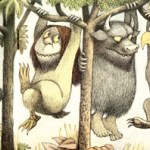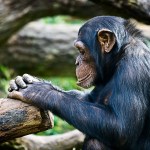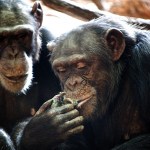Human Evolution
Author's Note: The following is an excerpt from my review of Sex At Dawn: The Prehistoric Origins of Modern Sexuality. For additional information see my posts Reexamining Ardipithecus ramidus in Light of Human Origins, Those Cheating Testicles, or Who's Your Baby? as well as Helen's Lament and the Origins of Forbidden Love. Christopher Ryan also blogs at Psychology Today.
When we think of the first swinger parties most of us imagine 1970s counter-culture, we don't picture Top Gun fighter pilots in World War II. Yet, according to researchers Joan and Dwight Dixon, it was on military bases…
Is it a Falsehood that Humans Evolve from Apes?
How about this one: Is it a Falsehood that Humans did NOT evolve from Apes????
Yes and no. Humans descend from a population of primates from which other apes also descended (minimally the two species of living chimps) and which was part of the panoply of late Miocene forms, all related to each other, that we call apes. So yes, humans evolved from apes.
There are people who don't believe that. They, creationists, think that apes are apes and humans came from somewhere else, like the Garden of Eden or Mud or whatever. (This may depend on…
When most people think of evolutionary biology the first thing that comes to mind probably isn't lyrical poetry. However one of the earliest proponents of evolution, none other than Charles Darwin's grandfather Erasmus, presented his vision for the origin of life in the form of an epic poem in 1803. In his critically acclaimed work The Temple of Nature Darwin mused on the natural history of human beings:
Imperious man, who rules the bestial crowd,
Of language, reason, and reflection proud,
With brow erect who scorns this earthly sod,
And styles himself the image of his God;
Arose from…
Chimpanzees have culture (or not) depending on your definition.Image: Irish Wildcat / Creative Commons
Author's Note: The following is an expansion on my reply to anthropologist Dan Sperber on the PLoS ONE article "Prestige Affects Cultural Learning in Chimpanzees."
Culture is like art or pornography, it's hard for people to define but everyone knows it when they see it. Cultural anthropologists have long struggled to develop a consistent definition of the very thing that they study, a problem that has resulted in bitter arguments between scholars that, to an outsider, may seem as esoteric…
New research finds chimpanzees follow prestigious models when learning new tasks. Monika Thorpe / Creative CommonsIf one were to play psychiatrist to the natural world, most human beings would be committed for our certifiable obsession with other peoples' behavior. We compulsively examine, study, appraise, size up, and scope out what those around us are doing and then gossip with others about what we've seen or heard. New ideas or behaviors are especially compelling and will often have cultural critics…
Author's Note: This post was selected as the topic for the ResearchBlogCast as part of ResearchBlogging.org. Listen to the discussion here.
Could punishing bad behavior be the origin of human cooperation?Humans are one of the most cooperative species on the planet. Our ability to coordinate behavior and work collaboratively with others has allowed us to create the natural world's largest and most densely populated societies, outside of deep sea microbial mats and a few…
A few weeks ago I commented on the paper about the origin of the small dog phenotype in the Middle East. Now The New York Times has an article on a newer paper, New Finding Puts Origins Of Dogs in Middle East. Here's the conclusion:
Dog domestication and human settlement occurred at the same time, some 15,000 years ago, raising the possibility that dogs may have had a complex impact on the structure of human society. Dogs could have been the sentries that let hunter gatherers settle without fear of surprise attack. They may also have been the first major item of inherited wealth, preceding…
The Middle-to-Upper Palaeolithic transition in Cova Gran (Catalunya, Spain) and the extinction of Neanderthals in the Iberian Peninsula:
The excavations carried out in Cova Gran de Santa Linya (Southeastern PrePyrenees, Catalunya, Spain) have unearthed a new archaeological sequence attributable to the Middle Palaeoloithic/Upper Palaeolithic (MP/UP) transition. This article presents data on the stratigraphy, archaeology, and 14C AMS dates of three Early Upper Palaeolithic and four Late Middle Palaeolithic levels excavated in Cova Gran. All these archaeological levels fall within the 34-32 ka…
Artist rendering of Darwinius. Image: Julius T. CsotonyiLast year's publication of the fossil primate Darwinius masillae claimed it to be the oldest haplorhine primate ever discovered and a multimedia blitz campaign touted the find as the ultimate "missing link" (an erroneous term that should forthwith be forbidden to all science journalists). Brian Switek at Laelaps (who has an excellent review of this paper) made headlines for challenging the way that this fossil primate was rushed to market, and it seems…
Meet !Gubi, the tribal elder of a group of Bushmen (or Khoisan), one of the oldest known human lineages. He lives the life of a hunter-gatherer in the Namibian part of the Kalahari Desert. But he also has a strange connection to James Watson, the British American scientist who helped to discover the structure of DNA. For a start, they're both around 80 years old. But more importantly, they are two of just 11 humans to have their entire genomes sequenced.
Along with Archbishop Desmond Tutu, !Gubi is one of two southern Africans, whose full genomes have been sequenced by Stephan Schuster and…
Millions of people in Latin America have been invade by a parasite - a trypanosome called Trypanosome cruzi. They are passed on through the bite of the blood-sucking assassin bug and they cause Chagas disease, a potentially fatal illness that affects the heart and digestive system. The infections are long-lasting; it can take decades for symptoms to show and a third of infected people eventually die from the disease. But T.cruzi does much more than invade our flesh and blood; it also infiltrates our genomes.
T.cruzi is unusual in that a massive proportion of its DNA, around 15-30%, lies…
Meet "Inuk". He is the ninth human to have their entire genome sequenced but unlike the previous eight, he has been dead for some 4,000 years old. Even so, DNA samples from a tuft of his frozen hair have revealed much about his appearance and his ancestry.
Inuk had brown eyes and brown skin. His blood type was A+. His hair was thick and dark but had he lived, he might not have kept it - his genes reveal a high risk of baldness. Inuk may well have died quite young. Like many Asians and Native Americans, his front teeth were "shovel-graded", meaning that their back faces had ridged sides and…
Or not.
A repost
Much is made of the early use of stone tools by human ancestors. Darwin saw the freeing of the hands ad co-evolving with the use of the hands to make and use tools which co-evolved with the big brain. And that would make the initial appearance of stone tools in the archaeological record a great and momentous thing. However, things did not work out that way.
It turns out that up-rightedness (bipedalism), which would free the hands, evolved in our ancestors a very long time (millions of years) prior to our first record of stone tools. The earliest upright hominids that are…
... and made a real mess of the place when one of them spotted the jar of pickles on the counter. They fought over it until one of them had almost all the pickles and the other one had a number of bruises and a tiny fragment of one pickle that the other chimp dropped by accident.
A repost
That would be the way it would happen if two chimps walked into a bar. Or imagine two chimps, and each finds a nice juicy bit of fruit out in the forest. And instead of eating the fruit, because they are not hungry, they carry it around for a while (this would never happen, but pretend) and then…
Highly Punctuated Patterns of Population Structure on the X Chromosome and Implications for African Evolutionary History:
It is well known that average levels of population structure are higher on the X chromosome compared to autosomes in humans. However, there have been surprisingly few analyses on the spatial distribution of population structure along the X chromosome. With publicly available data from the HapMap Project and Perlegen Sciences, we show a strikingly punctuated pattern of X chromosome population structure. Specifically, 87% of X-linked HapMap SNPs within the top 1% of FST…
Is the Hobbit's Brain Unfeasibly Small?:
Brain expansion began early in primate evolution and has occurred in all major groups, suggesting a strong selective advantage to increased brainpower in most primate lineages. Despite this overall trend, however, Mundy and his colleagues have identified several branches/lineages within each major group that have shown decreasing brain and body mass as they evolve, for example in marmosets and mouse lemurs.
According to Mundy, "We find that, under reasonable assumptions, the reduction in brain size during the evolution of Homo floresiensis is not…
Sapolsky's talk begins at 5:00 after an introduction by the Stanford Provost.
The neuroendocrinologist and primatologist Robert Sapolsky has been one of my primary scientific influences and the reason I pursued my masters and PhD in primate behavior and evolution. Not only is he a brilliant researcher and writer, he's also a genuinely kind and supportive guy. Back in 2001, as an undergraduate, I wrote what was then my first fan letter to a neuroscientist. To my surprise he wrote back and we had an ongoing correspondence. He even recommended a piece of writing I had sent him to his editor…
One of the things about evolution you sometimes hear is that it has "stopped" for humans. Steve Jones, a British geneticist, is one of the more prominent public expositors of this viewpoint today. The key fact that most people latch on to is that infant and child mortality is very low, so the vast majority of humans reach the age of potential reproduction. Random genetic drift aside, evolution via natural selection does not necessarily need differential mortality as a necessary precondition (though this is obviously an efficacious mechanism from the viewpoint of evolution). All that needs to…
Men who think that size really matters should probably not think too hard about the Y chromosome. This bundle of genes is the ultimate determinant of manliness, and it happens to be a degenerate runt. Over a few hundred million years, it has shrunk considerably, jettisoning around 97% of its original genes. Where it was once a large library of genes, now it's more a struggling independent bookstore. This loss of information defined the youth of the Y chromosome but nowadays, things are different. Renovation is the order of the day.
Jennifer Hughes from MIT revealed the recent history…
In this TED Talk Susan Savage-Rumbaugh discusses bonobos housed in a bispecies environment that have been taught to communicate using pictographs. In the talk she suggests that biology isn't what made humans unique from nonhuman apes, but rather argues that it was cultural developments and social learning. Quite obviously there are some biological differences (around 1% of our genes differ, some of them coding for proteins important for brain formation). However, I challenge you to watch Kanzi build a fire and perform activities that require precise hand-eye coordination (including the…




